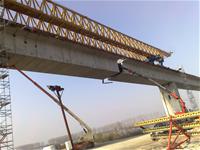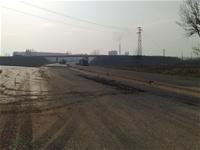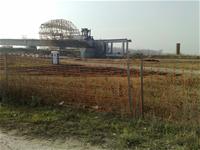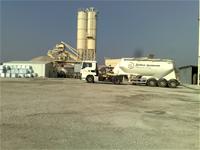Danube Bridge 2 - a parallel reality
Angel Shoilev, January 3, 2011
 And so, euinside is again hitting the road - this time intercity road and not very impressive one. Our main destination was Vidin, more specifically the construction of the famous Danube Bridge II. We decided instead of travelling via the highway to shorten the route and pass via the Petrohan passage. I am not sure, though, whether this was a good idea. Obviously the institutions that are responsible for maintaining roads either did not know about this very route or even if they do I prefer to think that they didn't in order to save myself asking rhetoric questions.
And so, euinside is again hitting the road - this time intercity road and not very impressive one. Our main destination was Vidin, more specifically the construction of the famous Danube Bridge II. We decided instead of travelling via the highway to shorten the route and pass via the Petrohan passage. I am not sure, though, whether this was a good idea. Obviously the institutions that are responsible for maintaining roads either did not know about this very route or even if they do I prefer to think that they didn't in order to save myself asking rhetoric questions.
While we were travelling I recall the endured history of the project
The idea of a combined direct auto and railway link between Bulgaria and Central and Northern Europe dates back in the 80s. The embargo against former Yugoslavia during the political crisis and the wars in the Western Balkans required even more the existence of such a link. The planning of construction works of a second bridge over the Danube river in Bulgaria starts in the 90-s. According to the plans the bridge was to be 1,971 meters long, including two lanes per direction for cars, a single electrified railway line and a bicycle alley.
On February 18 2005 the then minister of finance and a coordinator of European Union's assistance Milen Velchev and Dimitris Kourkoulas, then leading the European Commission' delegation in Bulgaria, signed a memorandum about the funding of the construction of the Danube Bridge II, estimated to cost 225.8 mn euros. The money were to be taken from the pre-accession programme ISPA, the European Investment Bank, the German Credit Institution for Reconstruction and the French Agency for Development - under the form of grants or loans.
Union's assistance Milen Velchev and Dimitris Kourkoulas, then leading the European Commission' delegation in Bulgaria, signed a memorandum about the funding of the construction of the Danube Bridge II, estimated to cost 225.8 mn euros. The money were to be taken from the pre-accession programme ISPA, the European Investment Bank, the German Credit Institution for Reconstruction and the French Agency for Development - under the form of grants or loans.
After the public competition in the end of 2006 the Spanish company FCC Construction S.A. was chosen for the main contractor of the project and the construction of the bridge, and the contract was signed on January 30th 2007. The initial term of implementation was 38 months and the overall cost of the contract was nearly 100 mn euros (99 955 948). According to the project's website from the beginning of the construction of the Danube Bridge II 980 new jobs have been secured and since the beginning of the project it is expected the local economy to receive 60 mn euros.
 Almost three years passed since the construction works began - it is true that I did not visit Vidin during these three years but if, indeed, only part of this money had entered the economy there I cannot imagine how the town looked before that. From what we saw the roads and in fact the entire infrastructure needs overall repairs or renovation. When we arrived in Vidin the feeling we had when seeing the town was only of abandonment. Because of the many closed plants and enterprises, a large part of the locals are jobless.
Almost three years passed since the construction works began - it is true that I did not visit Vidin during these three years but if, indeed, only part of this money had entered the economy there I cannot imagine how the town looked before that. From what we saw the roads and in fact the entire infrastructure needs overall repairs or renovation. When we arrived in Vidin the feeling we had when seeing the town was only of abandonment. Because of the many closed plants and enterprises, a large part of the locals are jobless.
People hope that after the bridge is completed things would change for the better. Indeed, after the end of the construction, investments in the region seem inevitable but will they be that significant as everyone is hoping? From what we saw the roads that are being built together with the bridge do not pass through the town. Of course the future development of Vidin is not the main goal of Danube Bridge II. Its main goal is a fast and reliable transport connection and communication.
No luck with the construction of Danube Bridge
Lately the construction of the bridge was delayed and postponed several times for  various reasons: complex geological conditions in the region; the year-long delay of permissions from Romania needed by the Spanish company to get access to the Romanian coast; the delay of the concession procedure for sand extraction needed for the construction works. Construction works continue but not with the planned and expected pace. Because of these "unforeseen circumstances" the forecast is the bridge to be completed in the second quarter of 2012 which is beyond the 38-months long term.
various reasons: complex geological conditions in the region; the year-long delay of permissions from Romania needed by the Spanish company to get access to the Romanian coast; the delay of the concession procedure for sand extraction needed for the construction works. Construction works continue but not with the planned and expected pace. Because of these "unforeseen circumstances" the forecast is the bridge to be completed in the second quarter of 2012 which is beyond the 38-months long term.
We could not ignore the opportunity to be taken around the construction site and the surrounding infrastructure. Although the bridge is far from ready the view is imposing. The spirit of all the prolongations and obstacles could be felt at some point. In other words - the huge project has encountered the mighty wall of bureaucracy in Bulgaria.
 Whether it is a matter of a view point or something else, I don't know. But according to prime minister Boyko Borissov who visited the construction site two weeks after we did, construction works are 55% complete. According to the Bulgarian representatives in FCC Construction S.A., 30% of construction works on the project are complete. Ivaylo Moskovski, deputy minister of transport, information technologies and communication said that the responsibility for sand extraction and the necessary raw materials is of the company-contractor of the project but it, he said, had undertaken the most prolonged procedure in terms of Bulgarian legislation to receive permission. On September 1 2010 the government approved the permission for research of raw materials of the Spanish FCC Construction S.A. but this would require even more time and would not boost the keeping of initials deadlines.
Whether it is a matter of a view point or something else, I don't know. But according to prime minister Boyko Borissov who visited the construction site two weeks after we did, construction works are 55% complete. According to the Bulgarian representatives in FCC Construction S.A., 30% of construction works on the project are complete. Ivaylo Moskovski, deputy minister of transport, information technologies and communication said that the responsibility for sand extraction and the necessary raw materials is of the company-contractor of the project but it, he said, had undertaken the most prolonged procedure in terms of Bulgarian legislation to receive permission. On September 1 2010 the government approved the permission for research of raw materials of the Spanish FCC Construction S.A. but this would require even more time and would not boost the keeping of initials deadlines.
Besides, according to initial calculations, there is a chance the costs of the two  contracts for the bridge and the accompanying infrastructure to exceed the agreement with the Spanish company by 90 mn euro. So far the money paid from the common budget of 225.8 mn euros is 107.7 mn euros. Because of the unforeseen delays, a letter was sent to the European Commission, asking for an extension of the financial memorandum, agreed with the Romanian partners too.
contracts for the bridge and the accompanying infrastructure to exceed the agreement with the Spanish company by 90 mn euro. So far the money paid from the common budget of 225.8 mn euros is 107.7 mn euros. Because of the unforeseen delays, a letter was sent to the European Commission, asking for an extension of the financial memorandum, agreed with the Romanian partners too.
And if on part of the contractor and the employer (the government) everything sounds somewhat OK, we have to mention the third part in the project - the subcontractors. According to companies-subcontractors or partners of subcontractors, they have not received their money for already done job. The Spanish company has refused to comment on such claims and the meeting we requested with the chief of the project was refused several times.
 On his behalf Mr Simeon Evtimov, head of the department for projecting and building of Danube Bridge II and the surrounding infrastructure, said that this was a problem that was related to the contractor and returned the ball into FCC's playground. Thus, our attempts to find out why the subcontractors had not received their money for already completed work were entrapped into a vicious circle. And after all, we are not talking only about Bulgarian or Romanian taxpayers' money but also European taxpayers' funds. Furthermore, in times of severe economic crisis the companies that dared take part in the project might wake up in an even worse financial situation instead of causing the so much needed economic recovery.
On his behalf Mr Simeon Evtimov, head of the department for projecting and building of Danube Bridge II and the surrounding infrastructure, said that this was a problem that was related to the contractor and returned the ball into FCC's playground. Thus, our attempts to find out why the subcontractors had not received their money for already completed work were entrapped into a vicious circle. And after all, we are not talking only about Bulgarian or Romanian taxpayers' money but also European taxpayers' funds. Furthermore, in times of severe economic crisis the companies that dared take part in the project might wake up in an even worse financial situation instead of causing the so much needed economic recovery.
It is obvious that for the government it is more important to note another success and fast construction, but in the end of the day it is better the construction works to go on more slowly but all the problems to be solved in time in the course of building.
Such is the situation around the building of the "second bridge of friendship" - the blame is being transferred from here to there. The reactions of the Bulgarian and the Romanian side are not adequate enough and flexible. Given the current problems it is impossible at this point to make any real assessment when the work on Danube Bridge II would be completed, nor how much it would cost in the end and whether the funding from the already closed pre-accession programme ISPA would not be lost.
blame is being transferred from here to there. The reactions of the Bulgarian and the Romanian side are not adequate enough and flexible. Given the current problems it is impossible at this point to make any real assessment when the work on Danube Bridge II would be completed, nor how much it would cost in the end and whether the funding from the already closed pre-accession programme ISPA would not be lost.
Anyway, what matters now is that work on the bridge continues and let's hope that the lost in administrative hurdles time would be compensated. Sooner or later the project, which is part of pan-European corridor 4, will be finished. Ready to contribute to the entire South-Eastern transport axis of Europe and the Trans-European transport network with opportunities for combined transport and for transfer of certain volumes of traffic from auto ways to railways.
Thanks to the construction part of the people in Vidin and the region have a job but what will happen after the construction works are over? In one moment or another Danube Bridge II will be ready but Vidin might remain the same. It is true that there are expectations for investments after the bridge is completed but what will attract investors in this town? Northwestern Bulgaria is one of the poorest regions in  Bulgaria and Europe. Currently Vidin is a constantly declining town, expecting a possible salvation from the unclear future of the second Danube Bridge. Although a look around the construction site shows several things - the participation of Devnya cement, given the availability of regional plants producing cement in the region. And also the fact that not a small part of the workers on the site are actually foreigners.
Bulgaria and Europe. Currently Vidin is a constantly declining town, expecting a possible salvation from the unclear future of the second Danube Bridge. Although a look around the construction site shows several things - the participation of Devnya cement, given the availability of regional plants producing cement in the region. And also the fact that not a small part of the workers on the site are actually foreigners.
So, we leave Vidin with mixed feelings - one of the biggest projects on the Balkans has a great chance to be completed. When, at what price and will it bring the expected benefits, we asked ourselves on our way back.